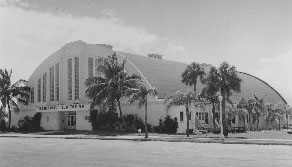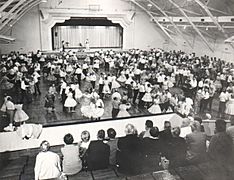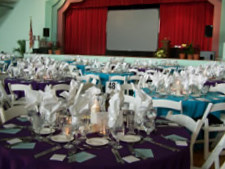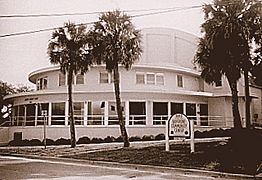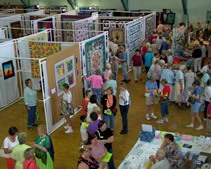Sarasota Municipal Auditorium facts for kids
Quick facts for kids Sarasota Municipal Auditorium |
|
|---|---|
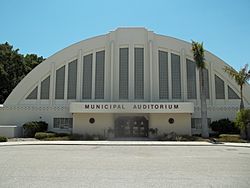
Front of Municipal Auditorium
|
|
| Alternative names |
|
| General information | |
| Type | Municipal auditorium |
| Architectural style | Art Deco and Moderne |
| Address | 801 Tamiami Trail North |
| Town or city | Sarasota, Florida |
| Country | United States |
| Coordinates | 27°20′35″N 82°32′52″W / 27.34306°N 82.54778°W |
| Construction started | July 1937 |
| Opened | February 24, 1938 |
| Renovated | 1997 |
| Cost | $131,000 ($1.97 million in 2021 dollars) |
| Owner | Sarasota |
| Height | 39 ft (12 m) |
| Technical details | |
| Floor count | 2 |
| Floor area | 10,000 sq ft (930 m2) |
| Design and construction | |
| Architect |
|
| Engineer | Freeman H. Horton |
|
Municipal Auditorium–Recreation Club
|
|
| Lua error in Module:Location_map at line 420: attempt to index field 'wikibase' (a nil value). | |
| NRHP reference No. | 95000164 |
| Added to NRHP | February 24, 1995 |
The Sarasota Municipal Auditorium is a cool old building in Sarasota, Florida. It was built in 1938 and is used for many different events. You can find it at 801 Tamiami Trail North. The city of Sarasota owns and runs it.
This building has a huge main floor, about 10,000 square feet, which is great for exhibits. It also has a stage designed in the Art Deco style. The auditorium is sometimes called the Sarasota Exhibition Hall or the Sarasota Civic Center Exhibition Hall. It sits on a big piece of public land used for city activities. Because it's so important, it was added to the U.S. National Register of Historic Places on February 24, 1995.
Contents
History of the Auditorium
The idea for a park and a big auditorium in Sarasota started in 1935. The Municipal Auditorium was part of a larger, 11-acre recreation area. This area was first known as the Civic Center or Bayfront Park.
Building with Community Help
In 1936, the city got the land for the auditorium. It was 37 acres and had been owned by a private company. Citizens and city workers then worked hard to get a special grant from the federal government. This grant came from the Works Progress Administration (WPA). The WPA was a government program that helped people find jobs during tough economic times. They did this by building public projects like roads and buildings.
In March 1937, some important business leaders in Sarasota loaned the city $10,000 for the project. These leaders included newspaper publishers, a circus manager, and the city attorney.
Construction and Opening
The federal government gave $131,000 for the project. Work on the auditorium began in July 1937. Skilled workers were paid by the city, and other workers were paid by the WPA. Many local businesses and leaders also gave money. The mayor at the time, E. A. Smith, said they planned to build "one of the finest recreation centers in the South."
The auditorium officially opened on February 24, 1938. Its first big event was the annual Sara de Soto Celebration, which was a community event. About 3,000 people came to the celebration!
Design and Features
The building was designed by architects Thomas Reed Martin and Clarence A. Martin. They used the Art Deco and Moderne styles, which were popular at the time. Freeman H. Horton was the engineer. He designed the special support system for the curved roof.
When it was first built, the auditorium was right on Sarasota Bay. People could even go boating from the recreation center! Later, the shoreline was extended further out into the bay.
In 1940, a second floor was added to the western part of the auditorium. This addition was paid for by Ida and John Chidsey. It included a lounge, a recreation room, and a card room. Outside, they built areas for shuffleboard, lawn bowling, and tennis.
Auditorium During Wartime and Beyond
During World War II, the auditorium became the Army and Navy Club. It was a popular spot for dances, graduations, and concerts for soldiers and sailors.
The Florida West Coast Symphony, now called the Sarasota Orchestra, performed here for many years. They played from 1949 until 1969, when the Van Wezel Performing Arts Hall opened nearby.
What the Auditorium is Like Today
The Sarasota Municipal Auditorium has a unique curved roof. It also has many glass blocks on its eastern side. These blocks let in natural light, making the inside bright. The building's design is mostly Moderne and Art Deco. Some parts even look like the International Style.
The main floor is made of solid hardwood maple. This special floor helps with the sound and makes events more comfortable.
Today, over 100,000 people visit the auditorium each year! They come for all sorts of events, like:
- Banquets and parties
- Community meetings
- Concerts and dances
- Events for teenagers
- Fundraising events
- Health talks
- School proms and galas
- Training sessions
- Wedding receptions
The auditorium also hosts many exhibits and shows. You might find antique sales, art shows, auctions, coin shows, flower shows, and gem and jewelry shows.
The Hazzard Fountain
In 1940, a special fountain was given to the Municipal Auditorium by R.P. Hazzard. This fountain could light up! It was designed by Frank Martin, whose father, Thomas, helped design the auditorium itself. The fountain was called the "crown jewel" of the complex.
The Hazzard Fountain has been moved a few times. Because a road was made wider, the fountain was moved from its original spot. It was stored for years, then placed at the John and Mable Ringling Museum of Art in the late 1970s. After a few more years, it was moved and stored again. Finally, in 1995, the fountain was brought back to its original home at the auditorium. It was rededicated on January 6, 1996.
Bringing History Back: Renovation
The building was renovated in the 1970s. During this time, many of its original historic features were covered up. For example, the front of the building was hidden, and a large canopy was added. The cool glass blocks were also covered. Many changes were made inside too.
Restoring the Original Look
In the 1980s, a person working for the city pushed to get the building listed on the National Register of Historic Places. This helped start an effort to bring the building back to its original look.
Local architects and builders began the restoration work in 1992. They worked to make the building look like it did in 1937. On October 13, 1994, the city held a big party to raise money for the restoration.
Money for this major restoration came from the state and local governments. Many volunteers also helped with the planning. The Municipal Auditorium was officially placed on the National Register of Historic Places on February 24, 1995. It was recognized for its amazing architecture, engineering, and its long history as a public gathering place.
The renovation was finished in 1997. The inside of the building was carefully restored. The unique glass blocks were uncovered and made even stronger. The outside of the building also looks just like it did when it first opened!
Images for kids


